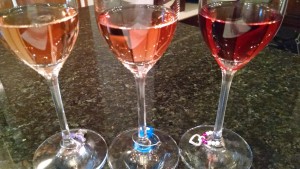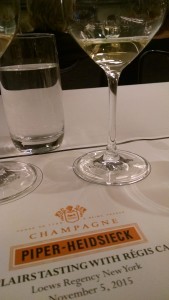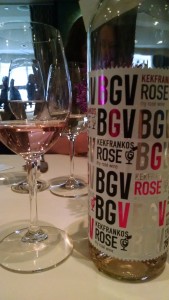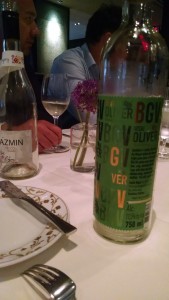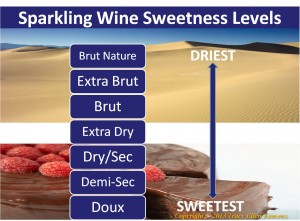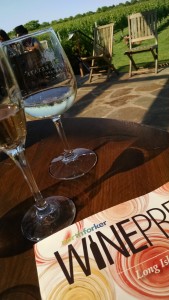 There is something special about visiting an island. The discrete borders, the intimate setting and the separation from the mainland all conspire to conjure images of a serene paradise. It’s why “Island Getaway” makes a much better headline than “Landlocked Getwaway”!
There is something special about visiting an island. The discrete borders, the intimate setting and the separation from the mainland all conspire to conjure images of a serene paradise. It’s why “Island Getaway” makes a much better headline than “Landlocked Getwaway”!
This summer, I had the pleasure of visiting several different islands, either in body (Long Island) or in spirit (Sicilia and Santorini), open to their charms through the lovely wines that are produced on each.
Close to home (aka New York City), Long Island provides a welcome refuge for city dwellers, with its beaches, farms and vineyards. We returned to the region after a two-year, accidental hiatus, stopping at some of our favorites for a brief refresher and to stock up our cellar, which we were about to deplete as a consequence of hosting our Meet, Meat & Merlot dinner, featuring a selection of aged Long Island Merlots.
The four-course dinner, held at our apartment, was an excellent opportunity to see how Long Island Merlot can develop with time. All of the wines, from the youngest at 12 years old (2003) to the oldest at 23 (1992), proved the point in spades. Between the chaos of cooking an elaborate menu and hosting 11 guests, I admittedly did not take notes on the wines, but the menu and wine selection are listed below.
Tasting notes for the various wines we tasted during our two-day visit to both the North Fork and The Hamptons AVAs are also included below.
Meet, Meat & Merlot Dinner Menu & Wines
Amuse Bouche: Frico Cheese Crisps with Hungarian Paprika
Wild Caught Salmon Sliders with Sage on Crispy Potato “Buns”
Shinn Estate Vineyards Estate Merlot 2003, North Fork of Long Island, USA
Shinn Estate Vineyards Six Barrels Reserve Merlot 2002, North Fork of Long Island, USA
¯
Coq au Vin 8 Hands Farm Organic Chicken Breast with Cipollini Onions & Mushrooms Lenz Estate Selection Merlot 2001, North Fork of Long Island, USA
Lenz Estate Selection Merlot 2000, North Fork of Long Island, USA
¯
Beef Wellington Organic Beef Tenderloin with Mushroom Duxelles and Foie Gras in Puff Pastry served with North Fork Squash and Sugar Snap Peas
Macari Vineyards, Bergen Road 1997, North Fork of Long Island, USA
Rivendell, Merlot 1990, North Fork of Long Island, USA
Rivendell, Merlot 1992, North Fork of Long Island, USA
¯
Dessert
Briermere Farms Raspberry & Peach Pie and
Briermere Farms Gooseberries and Wickham’s Farm Cherries
MACARI VINEYARDS
Macari Sauvignon Blanc 2014, North Fork of Long Island (NY), USA, $23.00
This wine is fresh and bright, with crisp citrus, a hint of green apple and long length.
Macari Dos Aguas Blanc 2013, North Fork of Long Island (NY), USA, $27.00
A blend of Chardonnay, Riesling, Viognier and Sauvignon Blanc. The intense nose displays aromas of lush pear and tropical fruit, both of which persist on the palate.
Macari Sauvignon Blanc No. 1 2013, North Fork of Long Island (NY), USA, $27.00 Macari has been actively experimenting with the use of concrete eggs and 60% of this wine was fermented in one. Compared to the regular Sauvignon Blanc, it was much rounder with lots of orange peel aromas and flavors.
Macari Cabernet Franc Lightforce 2013, North Fork of Long Island (NY), USA, $N/A
This wine was also fermented and aged in a concrete vessel. It was fresher and lighter than regular Cabernet Franc, but still very Cab Franc in its characteristics, with beautiful earth and mushroom notes.
Macari Merlot Reserve 2010, North Fork of Long Island (NY), USA, $36.00
From the near perfect 2010 vintage, this wine is absolutely gorgeous with rich notes of coffee and black cherry, culminating in long length.
 LENZ ESTATE
LENZ ESTATE
Lenz Estate Blanc de Noir Rosé 2013, North Fork of Long Island (NY), USA, $22.00
A light and pleasing rosé with fresh strawberry and slight herbal notes on the nose and palate.
Lenz Estate Old Vine Gewürztraminer 2010, North Fork of Long Island (NY), USA, $30.00
More floral than spice, this dry Gewurztraminer is quite elegant with nice acidity.
Lenz Estate Malbec 2011, North Fork of Long Island (NY), USA, $35.00
With intense and concentrated aromas of smoke, mulberry and blue fruit, this wine is more restrained on the palate, with elegant flavors of spice and blue fruit.
Lenz Estate Old Vines Cabernet Sauvignon 2002 North Fork of Long Island (NY), USA, $NA
This wine was showing some development with complex aromas and aromas of red fruit, black fruit and some meatiness. On the dry palate, it displayed ripe and concentrated flavors of blackberry, coffee and slight cedar; lovely.
McCALL WINES
McCall Pinot Noir 2012, North Fork of Long Island (NY), USA, $28.00
This wine offers fresh, bright fruit with notes of cherries, herbs and earth.
McCall Pinot Noir Hillside 2013, North Fork of Long Island (NY), USA, $39.00
This Pinot Noir is more complex and intense than the entry-level wine, with more meaty and spice notes.
McCall Merlot Reserve 2010, North Fork of Long Island (NY), USA, $30.00
This pretty and elegant wine displays rich black cherry aromas that pervade the palate as well.
McCall Ben’s Blend 2010, North Fork of Long Island (NY), USA, $54.00
Bringing together, Merlot, Petit Verdot, Cabernet Sauvignon and Cabernet Franc, this Bordeaux-style blend provides velvety tannins and nice complexity with gorgeous black fruit aromas and flavors.
CHANNING DAUGHTERS
Channing Daughters Tocai Mudd Vineyard 2012 North Fork of Long Island (NY), USA, 24.00
A combination of minerality and salinity greet the nose, while the palate is rewarded with apple and mineral notes and long length.
Channing Daughters Rosato di Refosco 2014, The Hamptons (NY), USA, $20.00 This rosé is distinctly herbal with sour cherry and a hint of salinity that lingers throughout the finish.
Channing Daughters Envelope 2011, The Hamptons (NY), USA, $42.00
Produced from 62% Chardonnay, 28% Gewurztraminer and 10% Malvasia Bianca, which were co-fermented with ambient yeast on the skins, this wine offers up pronounced aromas of floral and spice. This wine is rich, with concentrated fruit flavors of floral and pear on the palate.
Channing Daughters Ribolla Gialla 2013, The Hamptons (NY), USA, $35.00
This wine displays rich aromas of honey and marzipan. Its palate is dry with flavors of honey and white flowers.
Channing Daughters Sculpture Garden 2011, The Hamptons (NY), USA, $30.00
A blend of Merlot, Teroldego and Blaufrankisch, this wine spent 22 months in oak and 18 months in bottle before release. It has soft tannins, with notes of cherries, cocoa, and spice, which persist through the long finish.
NB: While I don’t have precise tasting notes, we absolutely adored Channing’s range of VerVino Vermouths.
WÖLFFER ESTATE
Wölffer Estate Noblesse Oblige Extra Brut Sparkling Rosé 2011, The Hamptons (NY), USA, $54.00
This elegant sparkling wine was very yeasty on the nose, with flavors of berries and cream on the palate.
Wölffer Estate Rosé 2014, Long Island (NY), USA, $18.00
Considered among the official rosés of the Hamptons, this fresh, Provencal-style rose is the perfect wine for summer with its purity of melon and berry fruit and refreshing acidity.
Wölffer Estate Summer in a Bottle 2014, Long Island (NY), USA, $24.00
This white blend offered up ripe, lush fruit with flavors of floral, peach and pear.
Grapes of Roth Dry Riesling 2014, Long Island (NY), USA, $26.00
Produced by Wölffer’s winemaker and partner Roman Roth, this is classic Riesling with citrus, slight pith, mineral, just a hint of off-dry sweetness on the attack.
Wölffer Estate Descencia Botrytis Chardonnay 2012, Long Island (NY), USA, $40.00
A late-harvest Chardonnay dessert wine with medium-sweetness, this wine is beautifully balanced by its bright acidity along with notes of honey, spice and Asian pear, culminating in long length.


